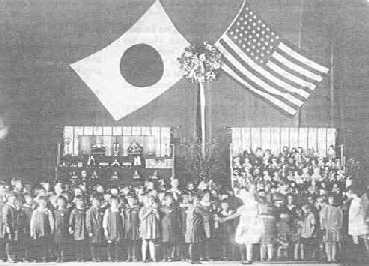|
Main Page
Children's Page |
|
1927 Doll Exchange
Historical Background Dr. Sidney L. Gulick Eiichi Shibusawa Mission of Friendship Preparations in US Receipt of Dolls in Japan Preparations in Japan Receipt of Dolls in US |
1927 Doll
Exchange
Receipt of Dolls in Japan

|
|
|
|
The official welcome in Tokyo to the Doll Messengers of Friendship |
The 12,739 American dolls received a huge and colorful welcome when they arrived in Japan in time to participate in the Hina Matsuri (Doll Festival) on March 3, 1927.
In January 1927, the first shipment of dolls aboard the steamship Siberia Maru arrived at the Port of Yokohama. Soon thereafter, several other steamships arrived with their small passengers aboard. The children and adults of Yokohama enthusiastically welcomed the dolls. At the reception ceremony held in a primary school auditorium, over 2,000 children attended, with even more children overflowing onto the wharf. Forty-eight of the dolls, representing each American state at the time, were handed by American children to Japanese children.
The American Friendship Dolls then proceeded on to Tokyo for the grand reception held on March 3, the day of Hina Matsuri. Mr. Charles MacVeagh, American Ambassador to Japan, concluded his speech with these words:
When you see and touch those dolls, you will find in every part of them evidences of the loving thought and sympathy with which they were made and dressed, and I am sure you will accept and treasure them in the same spirit in which they are offered; and I am equally sure that today will go down in the annals of history as one which has greatly helped to forge the chain of complete understanding and friendship between America and Japan, which, by the grace of God, shall never be broken.
After the huge welcoming parties in Tokyo, Osaka, and Yokohama and after being displayed for a short time in several large department stores in Tokyo and Osaka, the American Blue-eyed Dolls were distributed to elementary schools and kindergartens throughout the country. Each prefectural capital had a huge reception for the doll messengers of friendship.
After the prefectural reception had been held, the chief of the Department of Education decided which schools were to receive dolls, because there were not enough to go around for each school to get a doll. Each school receiving a doll got a letter from Dr. Sidney Gulick that expressed the hope that the children would have great fun with the American dolls and that Japan and America would always be loyal friends. The schools receiving dolls then had each its own reception, and these were the most intimate and appealing. In every school, the children brought their own toys and Japanese dolls, arranged them around the American doll, and spent a happy and pleasant time.
Miss America and 48 other dolls, representing the 48 states of America, went to live in a wonderful two-story doll house in the Imperial Education Museum in Tokyo. This large house, graciously given by the Empress of Japan, had several rooms so the dolls could live a comfortable and happy life.
Soon after receiving the American Friendship Dolls, Japan started preparations to send Japanese dolls to American children in order to express the country's deep gratitude for the tremendous gift of over 12,000 dolls.
Link to 1927 Japanese newspaper article about arrival of dolls: